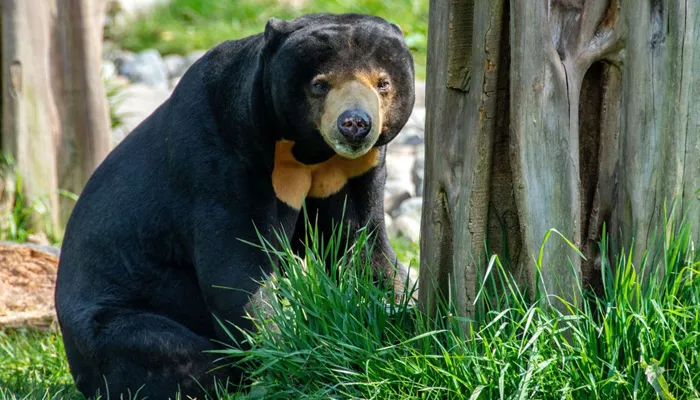The sun bear, a small yet mighty creature, is an often-overlooked species in the world of bears. With its sleek black coat and distinctive golden chest marking, it has earned its name as the “sun bear.” These intriguing animals have much more to offer in terms of their behaviors, diet, and conservation status. In this article, we explore 18 fascinating sun bear facts that highlight why this species deserves more attention.
1. Why is it called a Sun Bear?
The sun bear gets its name from the golden or white crescent-shaped mark on its chest, which resembles the rising sun. This distinct marking has made the bear one of the most recognizable species in Southeast Asia’s forests.
2. Where are Sun Bears Found?
Sun bears are native to Southeast Asia, specifically in forests across Borneo, Sumatra, and parts of mainland Southeast Asia. Their habitat includes tropical rainforests, where they play a critical role in the ecosystem.
3. What are Two Facts About Sun Bears?
Sun bears are the smallest bear species in the world, growing up to 1.4 meters long. They also have an impressive climbing ability, using their sharp claws and long limbs to scale trees in search of food or shelter.
4. Are Sun Bears Aggressive?
While sun bears are not typically aggressive toward humans, they can become defensive if threatened. They are solitary animals, and their natural behavior is more inclined to avoid confrontation than engage in aggression.
5. How Many Sun Bears Are Left?
Sun bears are considered vulnerable, with an estimated population of around 10,000 individuals in the wild. Due to habitat destruction and poaching, their numbers continue to decline, which makes them a conservation priority.
6. What is the Most Aggressive Bear?
Among the bear species, the grizzly bear (brown bear) is considered the most aggressive. In contrast, sun bears are relatively mild-mannered and shy, rarely exhibiting aggressive behavior unless provoked.
7. Why is the Sun Bear in Danger?
Sun bears face numerous threats, primarily from deforestation and illegal hunting. Habitat loss, poaching for their fur, and being captured for the illegal pet trade have led to a significant decline in their numbers.
8. Are Sun Bears Intelligent?
Yes, sun bears are highly intelligent creatures. They are known for their ability to use tools to extract honey from beehives and to break open tough tree bark in search of food. Their problem-solving skills are quite impressive for a bear.
9. What Eats a Sun Bear?
Sun bears have few natural predators, but they may fall prey to larger carnivores, such as tigers and crocodiles, especially when young. However, the greatest threat to their survival is human activity.
10. What is the Difference Between a Polar Bear and a Sun Bear?
The polar bear and sun bear differ significantly in size, habitat, and diet. Polar bears are large, white bears found in the Arctic, whereas sun bears are much smaller and live in tropical rainforests. Additionally, polar bears primarily eat seals, while sun bears consume a more varied diet, including fruits and insects.
11. Is the Sun Bear Safe?
Sun bears are not generally dangerous to humans and prefer to stay away from human settlements. However, they can be aggressive if they feel cornered or threatened, so it’s important to respect their space in the wild.
12. What’s the Friendliest Bear?
The friendliest bear species is often considered to be the Asiatic black bear. Known for its gentle nature, it is often seen foraging peacefully in the wild. However, every bear is wild and should be treated with caution.
13. Can a Human Beat a Sun Bear in a Fight?
Humans would not stand a chance in a physical confrontation with a sun bear. While relatively small compared to other bears, sun bears possess powerful jaws, sharp claws, and remarkable strength.
14. Do Sun Bears Eat Meat?
Sun bears are omnivores. While their diet consists mostly of fruits, honey, and insects, they also occasionally eat small mammals or birds. Their strong sense of smell helps them locate their food sources, including burrowing animals.
15. How to Protect a Sun Bear?
Protecting sun bears requires combating habitat destruction through deforestation regulations, enforcing anti-poaching laws, and supporting wildlife sanctuaries. Education and awareness also play key roles in ensuring their survival.
16. Are Moon Bears Extinct?
The term “moon bear” refers to the Asiatic black bear, not a separate species. While the Asiatic black bear is not extinct, it is classified as vulnerable due to habitat loss and poaching.
17. Can Bears Be Friendly to Humans?
Bears are wild animals and should be approached with caution. While some species, like the sun bear, may show curiosity around humans, they are not domesticated animals and should never be considered pets.
18. What is the Strongest Animal in the World?
The strongest animal in terms of relative strength is the dung beetle, capable of pulling over 1,000 times its body weight. However, when considering sheer physical power, animals like elephants and gorillas hold the title for strongest.
Conclusion
The sun bear is a fascinating and misunderstood animal that deserves our respect and attention. Despite being one of the smallest bear species, their unique traits and intelligence make them an important part of the ecosystem. However, due to growing threats, it is crucial that we support efforts to protect these incredible creatures from further decline.
Related topics:


